Pynchon is Everywhere, for Those With the Eyes to See
On Dumb and Dumber, Thomas Pynchon, and the history of the tv dinner
It began as a joke.
Friday night. My wife and I had just gotten the baby to bed. I whipped up a couple of Probitas daqs and a bowl of popcorn. It was the last weekend of summer vacation. Amy was about to have to return to her teaching position. Baby was about to start daycare. We wanted some mindless movie night fun so as not to think about that. Having recently visited Estes Park where we toured the grounds of The Stanley Hotel, famous for serving as Stephen King’s inspiration for The Shining, but not feeling quite up to Kubrick’s adaptation, we decided to watch the other big hit with ties to that spot.
The hotel scenes in the Farrelly brothers’ 1994 comedy, Dumb and Dumber, were filmed there, so we thought it’d be fun to throw it on, and see if we recognized any of the sights.
Well, I did my best to turn on, tune in, and enjoy the show, but that proved difficult to do. You see, I have had Thomas Pynchon on my mind rather incessantly as of late— in part because I always do, but also because I’d been re-reading Inherent Vice during our trip and doing research for my recent essay, but mostly because Brat Summer is long over and Pynchon Autumn is almost upon us.
It kicked off with another surfacing of a series of photographs and the accompanying rumors that young Tom might have been present at the 1965 Newport Folk Festival to see Dylan go electric.
When I texted my friend Matt the link, he was not too surprised, saying he’d always figured Pynchon to be some counter-cultural Forrest Gump figure, present at every legendary sixties event, which begs the question: Where were you on November 22, 1963, Tom?
Any other year, the photos might have been the highlight on Pynchonistas’ calendars, but this is no normal year, so they served merely to whet the appetite. At the time of this piece’s publication, we will be about six weeks out from the release of One Battle After Another, Paul Thomas Anderson’s Vineland adaptation. Which, again, could have kept us sated for years to come, as his previous Pynchon adaption did, but this blessed year even that offering is not the Main Course. That role has been usurped by the announcement of an unexpected, and surely final, novel from The Big Man himself, coming out, not coincidentally, on October Seventh.
So of course I have been thinking about him on some level rather incessantly. How could a young literary man such as myself not? But this back burner preoccupation became increasingly pronounced as the film rolled on and my first daq waned. By the time I mozied into the kitchen to throw together a second, one could say I’d even grown a little paranoid. My mind was racing, checking and cross-checking dates.
Dumb and Dumber was released in 1994. Plum in the middle of the seven year stretch between Vineland (1990) and Mason & Dixon (1997). But would he really have taken time away from working on his most ambitious project since Gravity’s Rainbow to focus on a screwball Hollywood comedy? What the hell are you on about, Gnas?
Just bear with me—
The Names
It was Jim Carrey’s character’s name that really started setting off the alarm bells.
Lloyd Christmas.
That’s a Pynchon-ass name if ever there was one one. And as I sucked down my next daq, I found there were plenty of other telltale signs, for those with the eyes to see.
Harry’s van, the shagging wagon, a 1984 Ford Ecoline in furs, is a sad inversion of a common Pynchon trope. Vehicular love is a running motif throughout his work. There’s a fetishization of the automobile across his oeuvre all the way up to and including vehicular fucking in Vineland, but more commonly the car acts as an extension of identity, something put most succinctly by ex-used car salesman, Mucho Maas:
“at least he had believed in the cars. Maybe to excess: how could he not, seeing people poorer than him come in, Negro, Mexican, cracker, a parade seven days a week, bringing the most godawful of trade-ins: motorized, metal extensions of themselves, of their families and what their whole lives must be like, out there so naked for anybody, a stranger like himself, to look at, frame cockeyed, rusty underneath, fender repainted in a shade just off enough to depress the value, if not Mucho himself, inside smelling hopelessly of children, supermarket booze, two, sometimes three generations of cigarette smokers, or only of dust— and when the cars were swept out you had to look at the actual residue of these lives. . .it made him sick to look, but he had to look. . . he could still never accept the way each owner, each shadow, filed in only to exchange a dented, malfunctioning version of himself for another, just as futureless, automotive projection of somebody else's life. As if it were the most natural thing. To Mucho it was horrible. Endless, convoluted incest” (4-5).
That Harry has spent his life savings to convert his personal van into this sheepdog on wheels in hopes of furthering, or at least securing, his career as a dog groomer means he has, in a way, traded over part of his self, his soul, to a company that, clearly, pays him almost nothing, and fires him at the drop of a hat. Furthering this theory is the costume Harry dawns in order to match not only his vehicle, but also his canine clients.
Unlike Slothrop, who is freed by the Zone’s deterritorialization even when dressed as a pig, Harry is caught within the strict structural matrix of imposed meaning. Whereas in The Zone, Pig is able to take on new, even heroic, identities and meanings depending on the context it is plugged into, Harry’s Dog is caught within nineties corporate America. The end of history. The Soviet Union has fallen. There is no viable alternative to liberal democracy and capitalism. And here, a dog is a dog is a dog. And a man dressed as a dog is even lower than that. There is nowhere he could go in corporate America, wearing such a costume, and be anything but a clown. He has sold his identity and his dignity and any chance at upward mobility just for a chance at a job that would allow him bare subsidence, and in response he receives a boot to the face from the dog-showing elect.
Still not convinced? Add in the worm farms, mafia hitmen, intelligence agents, horny idiots getting tangled up in the rich and powerful’s shadowy schemes, cases of mistaken identity, the vast array of settings, and, folks, you’ve got yourself a Pynchon novel.
So I posted the note. It got some light attention, and I thought nothing of it.
But then the phone calls started.
Blocked numbers. Garbled voices. Warnings to back off. Drop it.
Fuhgeddaboudit.
Well, dear reader, we here at Gnostic Pulp are not ones to be intimidated off a lead as juicy as that, so we did some digging. Pulled some strings. Got in touch with Mr. Carrey himself, who is semi-retired these days, seemingly willing to get in front of the camera only in order to reprise his role as Doctor Eggman in the ongoing Sonic the Hedgehog saga. Although he declined to meet, I did catch him in a good mood. He’d just bagged a neat $20 mil for his LA home, so he was willing to throw me a bone.
“Sure, there was loads we shot that didn’t get used. Film is all about what gets left on the cutting room floor, after all. It’s more like sculpture than anything else. But that was a busy year. My big break. I was filming three projects at once. Practically living on set. Having to move in and out of all these different characters while trying not to forget myself. Who even is Jim Carrey? I started to think. Well, that question got put on the back burner for a while because I received a small nation’s gdp in cash. I was all of thirty years old, had been homeless not too long before that. So what I’m saying is, it’s all a bit fuzzy up here, don’t remember a whole lot of it, but I do recall some stuff happening behind the scenes. I knew enough by then not to ask too many questions, but there was some stuff in the original script that the producers did not want to get out. There were re-writes, tons of reshoots, but I don’t think any of it was actually totally cut. It just went underground. Pull the right string, and the whole latticework of meaning might just reveal itself. Look at the names.”
“That’s what tipped me off. Lloyd Christmas.”
“No, not mine. That was just a dumb joke. If Lloyd ever did hit upon that one in a million chance and get hitched, well what would Mary’s name be.”
“Mary,” I say slowly, with growing distaste as the joke revealed itself. “Christmas.”
“See. Good for a chuckle, but nothing else. No. Not my name. Look at the others.”
“Sea Bass?”
“That one’s a hint. A clue. Keep swimming, little fishy. You’ll get there. Like the salmon of Capistrone.”
Click.
Names. Fish. It was back to the cork board for this gumshoe. IMDB, thankfully, revealed just over a dozen named characters, and Jim had already ruled out his own, so I moved to the next on the list. Co-lead, Jeff Daniels’ character, Harry Dunne, admittedly did not seem very Pynchony, at least not on the surface, but with such a small sample size, I did not want to pass over any suspect, so I did a little digging and quickly found that the Dunne surname is derived from the Irish Ó Duinn which translates to ‘dark’ or ‘brown’, but that’s not the interesting part. The Ó Duinns are descendants of the noble O’Regan family. Now, take a wild guess what that name got Americanized into. That’s right. Harry Dunne is a descendant of one of Pynchon’s favorite targets, Ronald Reagan, if not genetically, than at least via political reproduction. That is, Reagan’s America reproduces Harry Dunnes.
It was something, so I tacked Ronald’s old mug on the cork board, secured him to Harry with some red string, and returned my attention to the glow of IMDB, and the next name on its list.
“Starts with an S! Swim, Swami, Slippy, Slappy, Swimmon, Sammon, Simmon, Swans, Swenson? Swanson?”
We don’t learn too much about the Swansons, but we do know they are very wealthy. Members of the elect, as opposed to Lloyd and Harry’s preterite, to put it in Pynchonspeak. We meet Mary in the opening scene when Lloyd picks her up in a limo to deliver her to the airport. She seems to be in Providence primarily to leave a briefcase full of cash which is meant to be picked up by a couple of henchmen and delivered to the kidnappers of Mary’s husband. Lloyd foils the plan by falling in love with her at first sight, or at least he got that old fashioned romantic feeling where he'd do anything to bone her, at first sight, so as he is watching her walk away, he notices she leaves her briefcase behind and rushes in to pick it up and try to return it to her, wanting desperately to play the hero in her eyes.
Arriving too late or, perhaps more likely, just at the wrong gate, he finds her plane is already gone, and shortly hatches a plan to bring it to her, at any cost, in Aspen, where the Swansons either live, or are at least vacationing.
In their cross-country journey to reach her, the pair take a wrong turn, and end up in Nebraska. While this serves some purpose to the plot, and delivers a couple of the best throwaway lines in the film—"That John Denver was full of shit, man”—the drama it mines, the loss of the van, the temporary break up of our pair, the eventual acquisition of the crotch rocket that will carry them the rest of the way, all could have taken place without veering so wildly off course. Say, the van broke down, or Lloyd wrecked it while Harry slept, etc. But no. They went to Nebraska, and by doing so revealed the true identity of the Swanson family.
The Swanson Company, purveyors of frozen tv dinners, was founded in Omaha, Nebraska.
Put together these clues, and who is Mary Swanson? None other than heiress to the Hungry-Man Frozen Dinner fortune. Is this what Jim wanted me to look into? I tried to call and ask, but the number was disconnected. I would just have to trust my gut, and my gut was telling me if the man is releasing a book about a runaway cheese heiress from Wisconsin, then why not a frozen tv dinner heiress from Nebraska?
Frozen Food
The thing about Pynchon is that he never ceases to remind his readers about the complex material history of everyday objects. As zany as his work sometimes is, it is not dreamlike, for dreams appear readymade, a single substance without history. The buildings in dreams are made of buildings. They have not been constructed. There are no bits and pieces that must be fit together in a particular way in order for the building to stand. It just is. Not so in Pynchon. Everything has to be brought into creation. Nothing just is. Every object has a history and those histories are totally tied up with each other, interdependent, to a mind-boggling degree.
Swanson’s Hungry-Man TV Dinners have not always existed. They were brought to the market in 1973 (same year as Gravity’s Rainbow). Some of you reading this may very well predate them. And before the Hungry-Man could even be conceptualized, a million other events had to transpire, and none of them were fated. They were made to transpire, not teleologically, but individually. Like Carrey’s vision of film, reality, too, is a sculpture carved out of the block of infinite potentialities.
Clarence Birdseye, speaking of Pynchon-ass names, was born in New York in 1886. Son of a lawyer, he grew up in the swanky Cobble Hill neighborhood in Brooklyn, and harbored an early interest for taxidermy, which he taught himself “by correspondence”. . . meaning mailing letters about how to stuff animals? My sources offer scant details. Anyway, he later attended Amherst, where he excelled in the sciences, and his interest in insects earned him the nickname ‘Bugs’, a name Pynchon himself might have cringed at, for he was allegedly self-conscious about his teeth which he felt made him look like Bugs Bunny.
Birdseye spent a summer between classes shooting coyotes for the USDA in the American Southwest, a job which, at the time, apparently earned you the title “assistant naturalist”. He briefly returned to school, but soon had to give up his education after his father and brother, which now I fear I am just being messed with by some Trickster bent on leading me off the path, because my sources indicate this motherfucker was actually named Kellogg Birdseye. I am beginning to wonder if reality itself is not a Pynchon novel. Anyway, these two lawyers, Kellogg and Clarence Sr., got themselves imprisoned for defrauding their employer, meaning the Birdseyes could no longer float the Amherst tuition of their sixth born.
Booted out of the so-called “Little Ivy” of Amherst, Clarence spent his next few years traveling the western and northern reaches of this continent. He spent time researching bloodborne pathogens transmitted by ticks in Montana before he settled into raising foxes and ice fishing amongst the Inuit on the coast of Labrador.
It was during his time amongst the indigenous of Canada that he had the idea of taking some of their traditional methods for preserving fish back to New York and scaling them up for mass production. If this doesn’t cause big red Pynchon alarms to go if in your skull, then start over with V and keep reading right on through Shadow Ticket, which should be released by the time you get to it.
Back in New York, Birdseye worked out his method for flash freezing seafood, figuring out how to retain a much higher quality and freshness than the older, slower procedures. He started his company, Birdseye Seafood Inc., and began hawking frozen fish filets, but quickly went bust. Ever the tireless entrepreneur, he continued to tinker with and improve upon his method, and eventually pivoted to selling the actual techniques and equipment needed, such as his double belt freezer, incorporating under the name General Seafood Corporation to do so, and in the process becoming the granddaddy of the $325 billion/year frozen food industry.
Birdseye continued to refine his technique until eventually he sold his company and patents to Goldsman Sachs and Post for $22 million dollars. Adjusted for inflation, that’s about $330 mil today. Not a bad get for the dropout son of a disgraced lawyer.
Despite forking over a third of a billion dollars, none of the bright minds at Post seem to have dreamt up packaging any of their newly acquired frozen products together in ready to go meal trays. That innovation would have to wait another two decades. Maxon Food Systems of Long Island, Pynchon’s home turf, introduced the first frozen meal trays in the early forties. These have become the butt of the joke for hack comedians everywhere since they were first introduced as in-flight meals. They were poised to become available for the at-home market as well, but the death of the Maxon Food Systems sion put an end to that.
Presumably, the war effort prevented much energy from being put into this sector, so further innovation was delayed another decade, meaning it was the Swansons, not the Maxons, for whom the stars would align.
In 1953, the Swanson Company had a problem: Thanksgiving had come and gone and they were left holding the bag with over a quarter of a million tons of frozen turkey meat loaded on refrigerated train cars. Now, if the average holiday turkey weighs around fifteen pounds, that would mean Swanson had the blood of thirty-three million three hundred thirty-three thousand three hundred thirty-three and a third turkeys, slaughtered in vain, upon their hands.
Not only were the poor birds’ frozen corpses contained in freight cars, but the refrigeration only worked if the train was kept running, so through the early days of December in 1953, as riots broke out in Iran following a visit from President Nixon so swiftly on the heels of a CIA-backed coup there, a short train banked back and forth between Omaha and the east coast as Swanson executives searched for a way to offload two hundred fifty thousand tons of frozen turkey meat.
One cannot help but recall the scene from Mason & Dixon when the cargo in the hull of the ship they are traveling on is revealed to be mutton:
“Here were the Representatives of ev’ry sheep he had ever spoken ill of,—and now he was at their Mercy. But they are dead, he told himself. Aye, but not only dead. Here was a category beyond Dead, in its pointless Humiliation, its superfluous Defeat,—stripp’d, the naked faces bruis’d and cut by the repeated battering of the others in this, their final Flock, they slither’d lethally ‘round him. He had a clear moment in which he saw them moving of their own Will,—nothing to do with the movement of the Ship,—elaborately, the way dancers at Assemblies danc’d.”
One cannot help but envision a Mad Men-esque boardroom full of sweating execs counting the cost of each second spent powering the train. Of course, there are differing stories about who stood up and delivered the home run idea.
It was either salesman Gerry Thomas, working alongside bacteriologist, Betty Cronin, or the sons of Swanson himself, Gilbert and Clarke, who came up with the idea to sell the turkey packaged alongside other holiday staples, such as stuffing and yams, as a ready-to-heat meal tray. It should go without saying that we here at Gnostic Pulp support the preterite salesman and scientist duo over ol’ Gilbert and Clarke, but, whoever it was, in the end, it would be the sons who would benefit the most. Their daddy rushed the meal trays to the market and sold ten million units in the first year.
The most remarkable decision was not the trays themselves, which, as we have covered, had already existed on airplanes for a decade, but to market them as TV Dinners. Only four years before launch, the number of American households with a television set was less than 10%, but by 1955 that number would skyrocket to 64%, and by the end of the decade it was nearly 90%.
At the same time, married women were entering the workforce in droves. This meant there was far less time for many of the domestic chores that had previously been married women’s primary responsibility. Advertisers showcased tv dinners as home-cooking made easy. It was all the old recipes that had once taken hours, but now they were readymade. Just take them out of the freezer, pop them in the oven for half an hour, and bam: dinner. Plus the subtle insinuation stamped on every box that this food should be eaten in front of the tv helped put butts in those couches, so really dinner and a show, and a godsend for advertisers everywhere.
Innovation would continue through the ages, with the oven giving way to microwave-safe trays, and every imaginable niche being filled, cuisine from Mexico to New Delhi, diet friendly portion-controlled meals to the over indulgent and bachelor-coded Hungry Man boxes, from organic to cheap junk, and everything in between, the frozen meal had arrived.
Is Harry’s tongue stuck to the ski lift pole a slapstick joke about the destruction of our tastebuds at the hands of frozen meal slop? Is Big Frozen Food the insidious shadow lurking behind the feminist triumph, ready to turn their emancipation from domesticity into fertile grounds for a brand new industry? Or is it Big Microplastic puppeteering the whole thing, using the frozen meal tray as a vehicle to deliver its payload straight into our guts? As always in Pynchon, They is a conglomerate. There is no single villain in his lair pulling all the strings, only an undergirding logic of profiteering slowly closing in on all remaining virgin soil.
But then who is Nicholas Andre, the man who infiltrated the Swanson elect in order to kidnap and hold for ransom one of their own? Is he a son of the fallen Maxon dynasty here to take back what he feels should rightfully be his? If not a Maxon, then maybe the child of Gerry Thomas and Betty Cronin, who, despite their parents’ invention, shared in none of the Swanson wealth, making him the true hero of the film, a son of the preterite who has managed to propel himself into the realm of the elect through sheer determination for vengeance, to incorporate himself amongst those very people who betrayed his parents, and then, when he is finally within striking distance, he is undone by a couple of horny idiots who think they have any chance with a modern day princess such as Mary Swanson?
Is that Pynchon’s hidden warning? That we, preterite masses, have been turned into slop-eating degenerate fools incapable of seeing who are true enemies are because we are too busy drooling over the slim waist and pretty face of Capital? Selling our souls for a chance at subsidence via one of Their companies, farming worms in our living rooms to keep our own feeble dreams alive, and then risking our lives in hope that They will look down upon us and smile, certainly not allow us into their elite club, but at least, for once, for one fleeting moment, recognize our existence?
Or, more likely, he had nothing at all to do with the film, but has only tapped into the secret codex of our world, so that applying his techniques to anything can draw out the Pynchon-ness inherent in everything. Like Bleeding Edge’s DeepArcher, every squirming inch of this world is tagged with something like hyperlinks, but, unlike their digital counterparts, the world’s granularity truly is infinite. Clicking down their rabbit holes might reveal some sliver of the truth, but follow after that white bunny too far and you are sure to get lost in the twists and turns, drowned in the interconnections and bottomless depths, and totally forget why you even came down here in the first place.
A Quick Announcement: My novel, The Warehouse, is now available in serialized form over on
, my fiction Substack. Step into this elevator and let me pitch it to you real quick.I’ve stood costumed on the side of the road, waving a sign at traffic; I’ve farmed crickets and flipped burgers; I’ve manned the dish pit in a middle school cafeteria, but the most miserable thing I’ve ever done to earn money is move boxes in a supermarket distribution center. This I did with a computer strapped to my wrist, tracking my every move, and urging me to keep pace or else be fired. I managed to survive about two years and then one day during the peak of the pandemic, I pulled into the parking lot, looked at the building, and just couldn’t do it. On a whim, I turned around and drove home, never looking back.
The thing that got me through the ten hour shifts was the silent, inward composition of The Warehouse, my darkly comedic re-imagining of the distribution center as a place the workers never leave. Instead, they sleep in hammocks high in the shelves and drink in a speakeasy beneath the floor; a creature stalks/stocks the aisles in the night, converting anything it comes across into a box to be shipped out with all the others; and mgmt is ever looking for ways to increase productivity, often at the expense of their employees' bodies, but when they takes things too far, a desperate escape attempt ensues. . .
The Warehouse descends into a surreal, pulpy adventure leading eventually to the very nightmare at capitalism's core, in this case a temple within a pyramid in a sub-basement of a regional grocery store's distribution center, accessible through a hidden door in mgmt’s office.
I, for one, think it’s pretty good, but no one ever wanted to publish it. So fuck it: it’s a Substack Novel now. If you like what I’m doing over here at Gnostic Pulp, I think you might enjoy it, but hey, why not find out for yourself?
Thanks,
Jacob



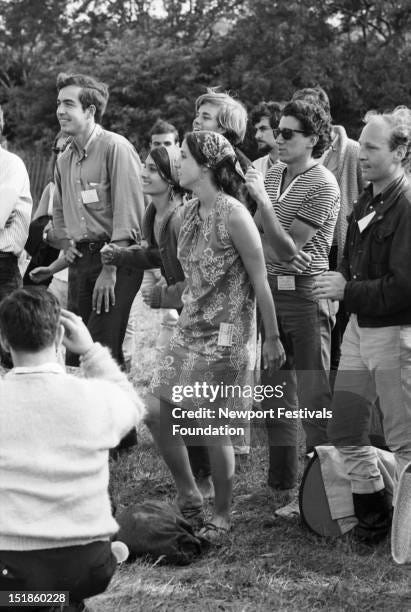
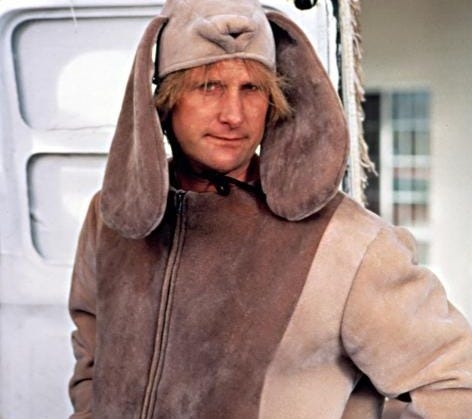
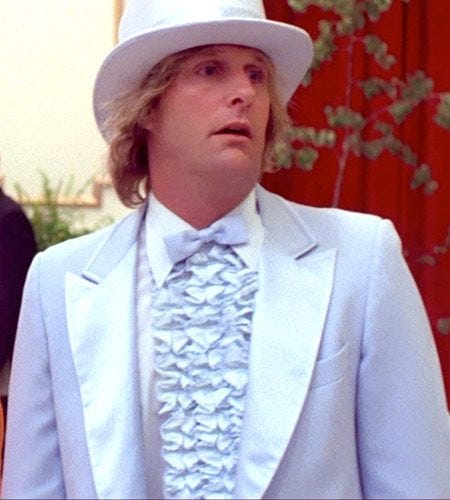
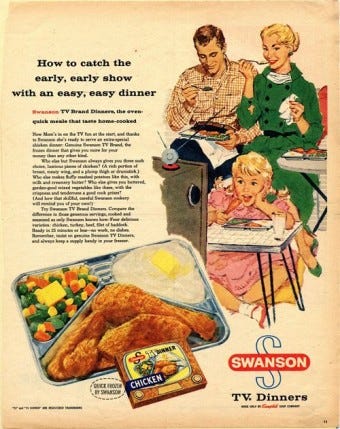
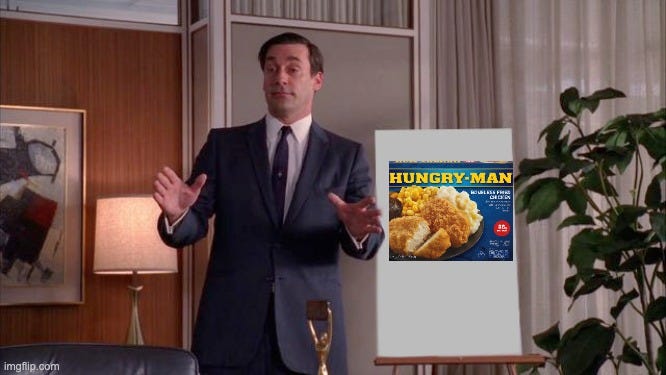
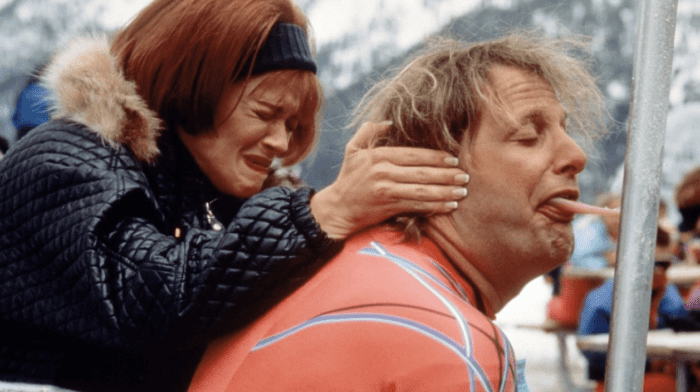
swanson heiress patricia married CIA propagandist dick carlson in 1979 and legally adopted his son, tucker swanson mcnear carlson
Great article, thanks. The surname Christmas appears in two other novels I can think of, Joe Christmas in William Faulkner's Light in August, and Willy G Christmas, owner of Mr Bones, the dog narrator of Paul Auster's Timbuktu. Can't remember if there's a dog in the Faulkner novel, but the Auster book also references to Steinbeck's Travels With Charlie (his poodle). The latter book is a whimsical journey through the US which ends with a searing indictment of racism in Louisiana. Faulkner's Joe Christmas is mixed race, a crucial part of the plot of the Faulkner novel. Not sure how any of this connects to Pynchon via the dog suit in Dumb and Dumber, or the guy in the bear suit in Kubrick's version of The Shining. I need a lie down.